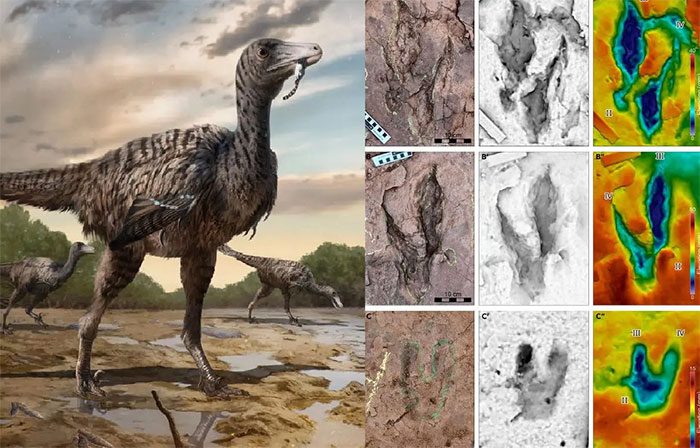Strange Creature in Fujian, China, Resembles an Ostrich but is Actually a Dinosaur, Described as “More Disturbing than Jurassic Park.”
According to Sci-News, an international paleontology research team has discovered a series of fossilized bird-like dinosaur footprints at the Longxiang fossil site in Fujian Province, China.
Among these, the smaller fossilized footprints measure 11 cm in length and belong to a known dinosaur species named Velociraptorichnus.
However, there are also gigantic footprints measuring 36 cm in length, revealing a completely new species of bird-like dinosaur.

Graphic representation of the new dinosaur species (left) and the discovered fossils – (Image: Yingliang/iSCIENCE)
Though fossilized footprints may seem less impressive than fossilized bones, they hold immense value for archaeology, especially when describing new species within a known group.
The footprints not only reveal the preliminary shape of the creature but also serve as a “3D negative film” depicting its external features, including skin texture and muscle fibers. This helps scientists reconstruct how the animal moved on land, leading to inferences about its behavior.
In this case, the well-preserved footprints have allowed China to add a new species to the Troodontid family, specifically Fujianipus yingliangi.
According to a publication in the journal iScience, this bird-like dinosaur and its relatives belong to a larger family known as deinonychosaur, which represents a transitional group between dinosaurs and birds.
Thus, like other bird-like dinosaurs, Fujianipus yingliangi has a body shape resembling that of an ostrich, with small wings and strong legs, but it still has teeth and is fundamentally a dinosaur.
It is also considered a top predator in its region.
“It stood about 5 meters tall with legs measuring 1.8 meters, far exceeding the size of the predatory birds depicted in Jurassic Park. Imagine something like that charging at maximum speed,” said Dr. Anthony Romilio from the University of Queensland (Australia), a member of the research team.
To identify the new species, the aforementioned footprints were compared with known dinosaur tracks from Asia, North America, South America, and Europe.
Most bird-like dinosaurs have been found in high-latitude regions near the Arctic, but the new discovery in Fujian indicates that this group of dinosaurs had dispersed further south than previously thought.
The research also involved scientists from the China University of Geosciences, Xiamen University, Yingliang Stone Natural History Museum, Fujian Geological Survey Institute (China), the University of Colorado Denver, and the College of Charleston (USA).



















































